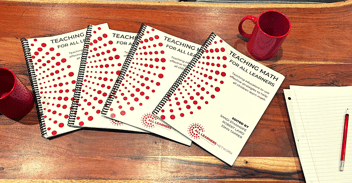
What is Explicit Systematic Instruction?
How can you support your students in interventions so that they are building conceptual understanding and connecting mathematical concepts and strategies to strengthen their understanding? One recommendation in the IES practice guide from What Works Clearinghouse (2009) is to provide systematic explicit instruction. But what exactly does this mean for our students?
Explicit and systematic instruction does not mean teaching by telling. There is a place for thinking, productive struggle and student reasoning, and exploration of topics while still being systematic and explicit in how you are providing the instruction, structuring the lessons and connecting mathematical ideas. We know productive struggle is essential for all students to gain mathematical insights. We also know that this takes practice. It requires that teachers know their students and provide appropriate tasks, scaffolding and questioning that makes the struggle productive and not frustrating. These are some of the scaffolding strategies that teachers may incorporate to make instruction and interventions more effective, more systematic, and more explicit for students.
Connect models and strategies
Some students may easily see that using an area model for multiplication is similar to partial products, but not all students will make that connection. For students not independently making connections, they will need explicit instruction in order to make connections between models, strategies and ideas. Class discussions, facilitated by the teacher, asking students to compare the models and approaches to solving the task illuminates these connections. Asking questions like “what is the same about these two strategies? What is different?” “Where do you see this part (of the partial product) in the area model?” Some students need to have intentional focus on how concrete, abstract and representational models to solve the same problem are connected, and to have conversations that highlight the mathematics underlying the different models to see their similarities. The IES 2021 Assisting Students Struggling with Mathematics: Intervention in the Elementary Grades guide again notes how this explicit connection should be a part of interventions.
Connect Mathematical Concepts
Systematic instruction includes intentionality considering how lessons connect and build upon one another and how mathematical concepts connect and build across lessons to develop deeper understanding and meaning-making over time. This again might require explicit focus on how different math ideas are connected or related to one another. Teacher content knowledge is critical in order to recognize how these concepts are connected. Using a launch number sense routine is a wonderful way to activate students' mathematical thinking, and support connections being made. Highlighting connections to past lessons, problems or strategies is another way to support students in making those connections. Questioning and class discussion are wonderful for this. The teacher can purposefully ask children to think about connected ideas, and they can learn from peers who are beginning to see those connections.
Model Thinking Aloud
Considering use of think alouds and modeling how to record students' strategies as they discussed them. This can be explicitly recorded and shown by the teacher in modeling how ideas can be communicated as well as how representations can be used to explain and show thinking. Articulating mental math steps and showing how this can be verbalized and recorded, as this skill of talking about thinking and how we think about math is not an easy one for students to master. For example a teacher might talk about how they solved 300-247 by thinking out loud, “I added 3 to the 247 to get to 250, then it is 50 more to get to 300 so 3 and 50 is 53, and 300-247 is equal to 53.” A teacher might instead model thinking about related facts or how a model or tool is being used to represent the problem situation. These skills will not come automatically, they will need to be practiced and for some students will also need to be modeled. Teachers thinking aloud show use of vocabulary, and represent ways that mathematicians explain and justify their thinking. Peers are another way students can see, hear and have thinking modeled. It could also be through a teacher revoicing a student's thoughts, or a teacher recording and notating a student's thinking. Again modeling how thoughts, ideas, and thinking can be shown with tools, models and numbers.
Provide Feedback to Students
Feedback is another crucial element to intervention, it is notated in the IES guides, but does not always come to mind when we hear “explicit and systematic.” However, feedback that is specific, intentional, and timely can really support learners. Asking questions of students, to elicit their thinking and requiring them to justify and explain their thinking can be a method of feedback. It could help the student to clarify their thinking as well, or to process their thinking in another way. To be effective, the feedback should move beyond marking or recognizing answers as correct or incorrect.
Allow Time for Practice
Practice is another essential element suggested in IES, that might not be what comes to mind when you think about systematic and explicit instruction. It is this opportunity to engage and practice using strategies that will allow students to begin to refine them, to consider when particular strategies are most effective and when another strategy might be better for a particular task. It also provides the time that students need, which might be especially valuable for those receiving intervention, because more time to explore ideas, apply math concepts and think about concepts strengthens understanding. For children to own the learning, it might take more time than you initially think to practice a concept. However, in the long run that investment in time has a positive impact.
Click here for the printable version.




